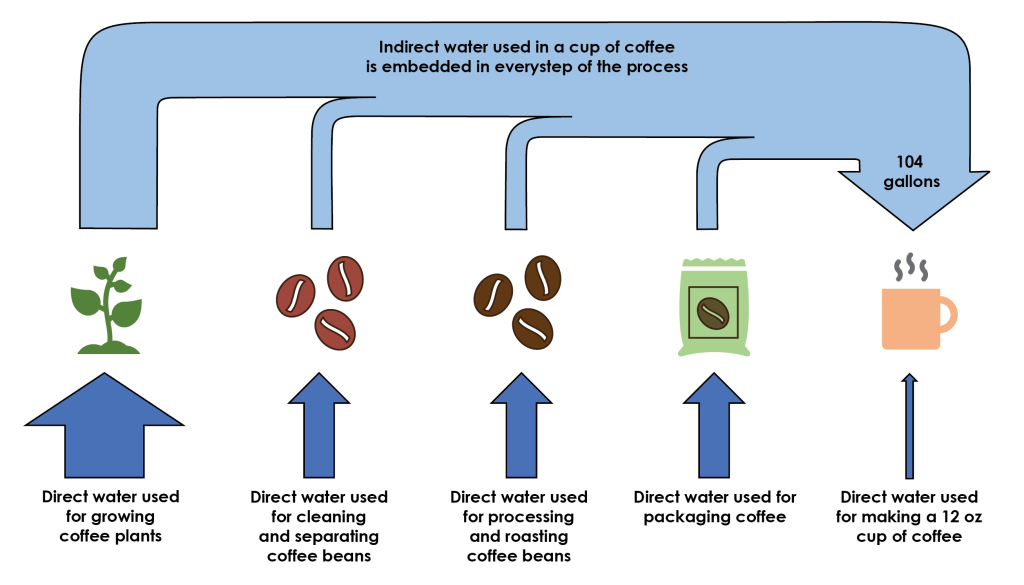1. Virtual Water
Water can be consumed directly or indirectly. Direct water use is water that is used directly from the tap. This would be uses such as washing hands, filling a water bottle, showering, or watering plants. Direct water use is highly visible and is the water use most people think of instinctively when they think about how much water they use daily.
Indirect water, or commonly called virtual water, is the unseen water embedded in producing goods. This is water that is consumed or polluted during the growing or mining to process and manufacturing of goods. For example, think about a 12 oz cup of coffee (the “tall” size at Starbucks). The direct water for this is the 12 oz used to steep the beans. But before the beans can be steeped, there is a lot of water used to grow the beans (Figure 2D.1.1). Then the beans need to be picked, shipped, separated, processed, cleaned, dried, milled, roasted, and packaged before they are ready to be made into a cup of coffee in the morning. All these manufacturing steps require water. For coffee, the indirect water usage adds up to about 104 gallons of water for a 12 oz mug of coffee!

Most daily water usage is in the form of virtual water. This is logical as approximately 70% of all freshwater worldwide is used in agriculture, and therefore becomes indirect water usage in goods. As different crops have different water needs, this also means the virtual water content in different food types varies.
The virtual water of animal products is significantly higher than the virtual water of crop products for the same caloric value in the human diet. For animals, there is water required to grow the crops used to feed the animals in addition to water for the animals themselves, water to keep animal cages clean, and then water for processing animal meat or other products such as milk and cheese. Most of the virtual water is used in the first step (growing crops to feed the animals), however, the number of crops in terms of caloric intake required to fatten up animals for human consumption is far more than if humans were to eat the crops directly. This works out to a virtual water content of 10 liters of water is embedded in 1 kcal of meat while only 1 liter of water is embedded in 1 kcal of vegetables. In other words, to get the same number of calories from a piece of meat requires ten times the amount of virtual water compared to getting those calories from vegetables.
A similar comparison can be made with highly processed versus unprocessed foods of a similar type (i.e., store-bought frozen chicken nuggets versus chicken cutlets breaded yourself at home). The more processed a food product is, the more water is required during processing, which increases the virtual water content.
While agricultural goods are widely discussed in this chapter as the focus is on water and agriculture, it is important to note that all goods have virtual water embedded in them. A mobile phone for example requires water during the mining process of the metals and other earth resources used to make the electronic components. Water is required during the extraction of petroleum resources used to make the plastic components. And finally, water is required during the manufacturing processes used to turn these raw materials into the final product.
Check your understanding: direct vs. indirect water use
Drag the example of water use into the column to identify it as a direct or indirect use of water.
References
Chapagain, A. K. and Hoekstra, A. Y., (2003). The water needed to have the Dutch drink coffee. Value of Water Research Report Series No. 14, UNESCO-IHE, Delft, the Netherlands. https://www.waterfootprint.org/resources/Report14.pdf
Schubert, H., (2011). The Virtual Water and the Water Footprint Concepts, acatech Materialien. 14. Munich. https://iufost.org/iufostftp/acatech_Materialband_Nr14_WEB_Korrektur_2012.05.pdf
